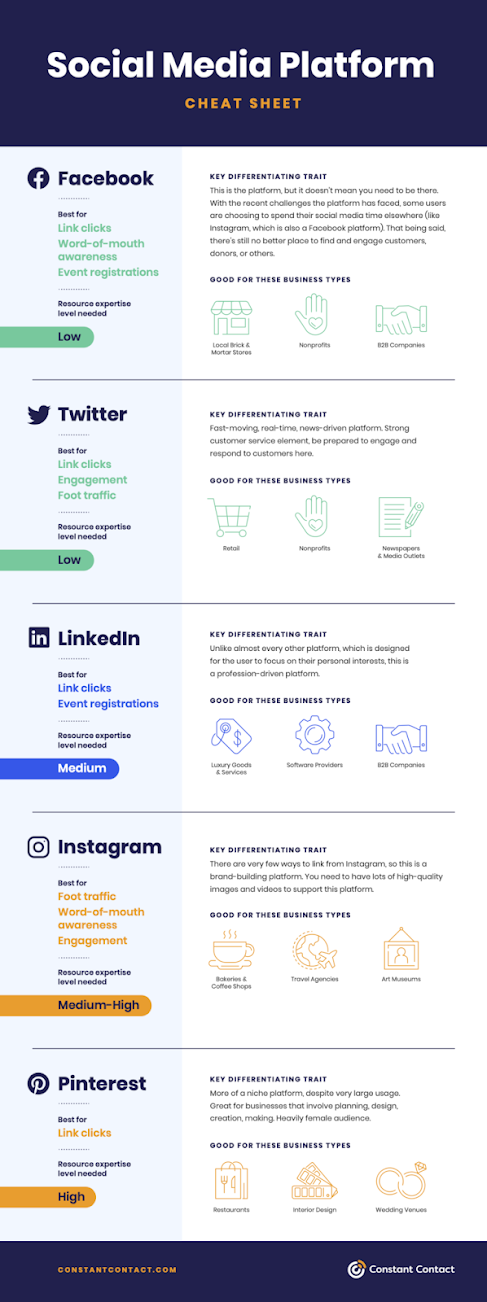The TL;DR Guide to Social Media for Business
To put it simply: using social media in your marketing mix is becoming a requirement if you want to scale your business in the digital era, regardless of size. However, social media is constantly evolving, and businesses that don't change their strategies with it often end up wasting money and seeing little return.
If you are have struggled to find the right social strategy or are new to social media for business, this post is for you.
Before we dive in, let's first discuss the importance of social media marketing, shall we?
Why Social Media Marketing is Important:
Set the Objectives:
Like any other marketing strategy the first, and most important step in the strategy development process is to identify your business objectives. This helps "determine not only the social platform you choose, but the content you create, the audience you target, and more" (Digital Marketing Institute, 2017). Objectives will vary depending on your business type and industry, but may include:
- Increasing brand awareness
- Improving your ROI
- Developing stronger relationships with your consumers
- Increasing website traffic
- Increasing conversions
- Improving your customer service
- Learning more about the wants, needs, and habits of your audience
Know your Audience:
Before choosing a platform (or platforms) you must have a solid understanding of your target audience. You likely already do, but I implore you to dig deeper. What sites do they--and people like them--hang out on? What kind of content do they engage with? Which influencers do they follow? The Digital Marketing Institute (2017) suggests that one simple and straightforward way of getting this information is through a customer survey.
Choose your Platform:
There is so much value in social media marketing, but if you are operating on the wrong platform your business won't experience those results. Be sure to do your research before committing to a platform; this will ensure you are getting the right message, to the right people, in the right place.
Sprout Social is a great resource to find information about social media demographics and user statistics for each platform, and there are tons of others available with a quick Google search.
Constant Contact (2020) also has an awesome cheat sheet to finding the right social platform for your business:
Post Consistently:
Once you have completed the first three steps, you are ready to start planning and creating content for your selected custom channel. For many, this is the hardest part.What should I post? When should I post? How often should I post? -- It can be overwhelming, but the key is consistency.
From the tone used to your profile aesthetic and everything in between, each component of your content should leverage your brand identity to effectively communicate your message to your target audience to further establish brand recognition. If you want your followers to be loyal followers, authenticity and strong brand recognition are essential.
You also want to ensure your followers know what to expect from you and when. Creating a content schedule is a great way to stay on track consistently. "This will also help you avoid posting too much, which can be off-putting for your followers" (Kuligowski, 2020).
Creating a content series is a great way to effectively plan your consistent content. "By providing relevant content at a consistent clip, you can build a habit among your audience to look forward to seeing specific content from your brand" (Barnhart, 2020).
Make it Fun:
TL;DR Guide to Social Media for Business:
1. Craft Your Strategy:
As the saying goes, "you must walk before you run." A social media strategy is only as strong as its foundation, so start by setting clear objectives and goals, and identify the necessary metrics to acheive those goals. Finally, research, research, research, and choose the platform(s) that best support your goals and best reaches your intended audience.
2. Know your Audience:
Knowing beyond a surface level who your audience is makes it much easier to plan and produce content that effectively communicates your brand story. Being able to truly connect with your audience is essential if you want to see long term growth from a social media strategy.
3. Be Consistent:
Being consistent with your content.
Utilizing a posting schedule ensures that consistency in when and what you post. Outline a schedule for out each day, week, and month's posts for each social media channel, and make sure that you stick with it.
4. Make it Fun:
Fun content is engaging content; engaging content creates engaged audiences; engaged audiences are loyal audiences. Lather, rinse, repeat.
References:
Barnhart, B. (3 August 2020). 20 social media ideas to keep your brand’s feed fresh. Retrieved on April 4, 2021, from http://sproutsocial.com/insights/social-media-ideas/
Constant Contact (2 September 2020). Best Social Platforms for Businesses. Retrieved on April 4, 2021, from https://blogs.constantcontact.com/which-social-media-platform-is-right-for-your-business/
Digital Marketing Institute (30 November 2017). Which Social Platforms Should You Use for Your Business? Retrieved on April 5, 2021, from https://digitalmarketinginstitute.com/blog/which-social-media-platforms-should-you-use-for-your-business
Kuliogowski, K. (6 August 2020). Step-by-step Social Media Marketing Guide for Small Businesses. Retrieved April 4, 2021, from https://www.business.com/articles/social-media-marketing-guide/?_ga=2.29656189.376705531.1617649364-1521537191.1617649364
Tankovska, H. (28 January 2021). Number of Global Social Network Users 2017-2025. Retrieved on April 4, 2021, from https://www.statista.com/statistics/278414/number-of-worldwide-social-network-users/#:~:text=Social%20media%20usage%20is%20one,almost%204.41%20billion%20in%202025.







Strategy is key to your and your targeted base. You can’t base your strategy on someone else’s strategy…not even your competitors.
ReplyDeleteThank you very much for writing such an interesting article on this topic. This has really made me think and I hope to read more. زيادة مشتركين يوتيوب
ReplyDelete